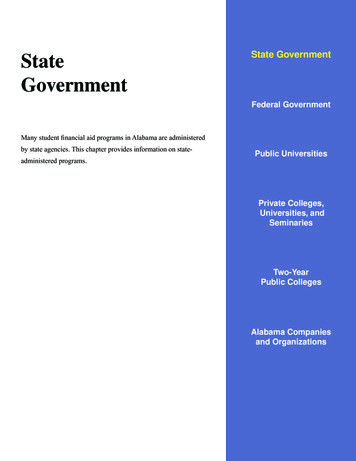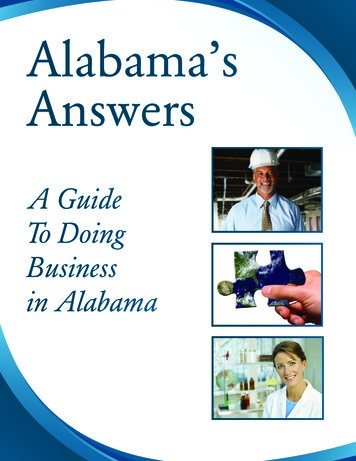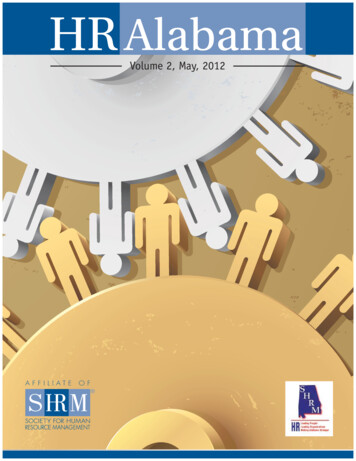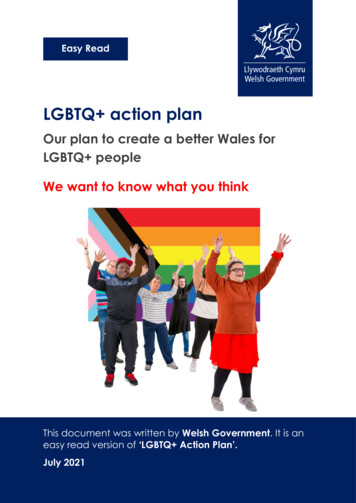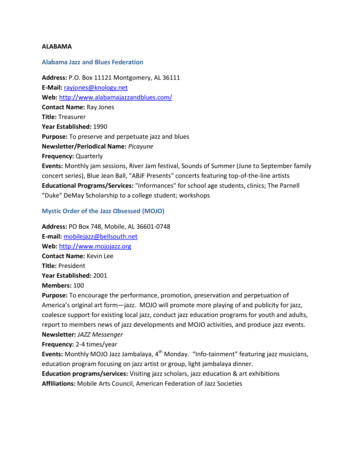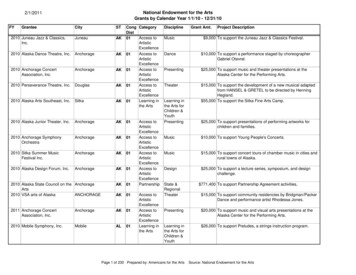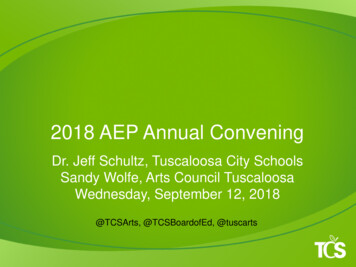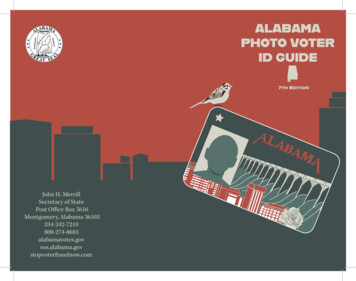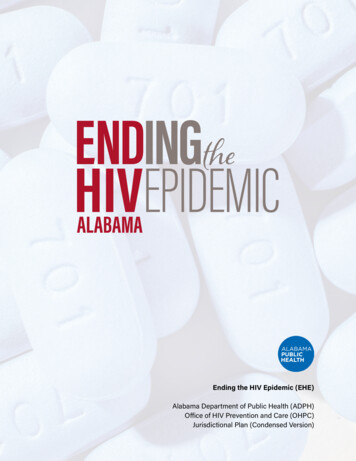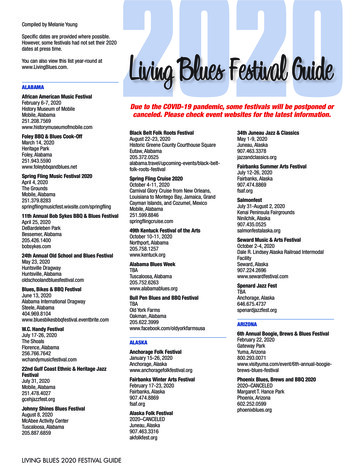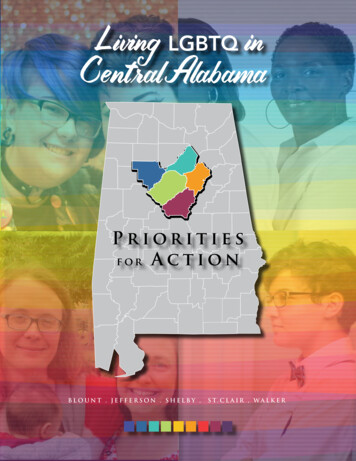
Transcription
Living LGBTQ inCentral AlabamaJefferson, Shelby, Blount, St. Clair, and Walker.Prioritiesfor A c t i o nBLOUNT . JEFFERSON . SHELBY ,Li vi ngLG B TQi nCen tralAlab am aS T. C L A I R , W A L K E RPr i o r i t i e sf o rAc t i o n1
2Li vi ngLG B TQi nCe n tralAlab am aPr i o r i t i e sf o rAc t i o n
Living LGBTQ in Central AlabamaPriorities for Action SPONSORSALGBTICALAIDS AlabamaAlabama Safe Schools Coalition (ASSC)Birmingham AIDS OutreachCommunity Foundation of Greater BirminghamCovenant Community ChurchGeorge and Genie TaylorHayden’s ListHuman Rights Campaign - AlabamaJefferson County Dept of Health (JCDH)Living in LimboLGBTQ FundMagic City Acceptance CenterMagic City Acceptance ProjectMagic City Wellness CenterMetropolitan Community ChurchOne RoofPFLAGState & UnionUAB Department of PsychiatryUAB Department of SociologyUAB SOPH-School of Public HealthUAB 1917 ClinicUABMC, UAHSFThe Palette FundLi vi ngLG B TQi nCen tralAlab am aPr i o r i t i e sf o rAc t i o n3
Planning CommitteeLeft to right:Sheree Wilkerson. Program Associate. Community Foundation of Greater BirminghamAnn Atkinson. Community VolunteerGina Mallisham. Project Coordinator Magic City Acceptance Center / Birmingham AIDS OutreachGeorge Taylor. Shared Goals. Community VolunteerAmanda Wilson. PFLAGDaronesha Duncan. AIDS AlabamaGordon Sullivan. Operations Coordinator. One RoofKyle Pugh. Director. Magic City Wellness Center. Central Alabama PrideKaren Musgrove. Executive Director Birmingham AIDS Outreach / Magic City Wellness CenterStephanie Perry. Administrative Manager. UAB Department of PsychiatryMaria Hernandez. UAB School of Public Health. InternAarin Palomares. UAB School of Public Health. InternJasmine Crenshaw. UAB School of Public Health. InternGlenda Elliott. Alabama Safe Schools Coalition / The Association for LGBT Issues in Counseling of AlabamaGenie Taylor. Shared Goals.Amy Sedlis. B-Heard Project Manager. UAB School of Public HealthKathie M. Hiers. CEO. AIDS AlabamaJanet M Bronstein. UAB School of Public HealthShayne Rittman. United Way of Central Alabama4Li vi ngLG B TQi nCe n tralAlab am aPr i o r i t i e sf o rAc t i o n
Table of ContentsExecutive Summary. 7Key Findings The LGBTQ Community. 8LGBTQ Issues for Central Alabama Service Organizations. 91. Introduction – Purpose and Methods. 102. Overview – The LGBTQ Population in Central Alabama. 123. The School Experience for LGBTQ Youth. 194. The Family Experience for LGBTQ Individuals. 265. Medical Care for LGBTQ Individuals. 336. Mental Health Care Issues Faced by LGBTQ Individuals. 387. Public Spaces. 438. Aging Issues. 519. LGBTQ Support Systems. 55APPENDIX: Legal Issues Facing LGBTQ Individuals in Central Alabama. 61DATA CHARTS. 69Li vi ngLG B TQi nCen tralAlab am aPr i o r i t i e sf o rAc t i o n5
Living in Limbo Photography by Carolyn Sherer6Li vi ngLG B TQi nCe n tralAlab am aPr i o r i t i e sf o rAc t i o n
Jefferson, Shelby, Blount, St. Clair, and Walker.Living LGBTQ in Central AlabamaPriorities for ActionE X E C U T I V ES U M M A R YThis report summarizes the results of the Living LGBTQ (Lesbian, Gay,Bisexual, Transgender and Queer/Questioning) in Central Alabama (LLCA)Needs Assessment, conducted in 2015 on behalf of the LGBTQ fund of theCommunity Foundation of Greater Birmingham.The needs assessment was guided by a stakeholder council that included representatives fromBirmingham AIDS Outreach (BAO), Birmingham Alliance of Gay, Straight and Lesbian Youth, AIDS Alabama,United Way of Central Alabama, Parents Families and Friends of Lesbians and Gays (PFLAG), Magic CityAcceptance Project (MCAP), the Magic City Acceptance Center, the Alabama chapter of the Human RightsCampaign, Safe Schools Coalition, The Jefferson County Department of Health (JCDH), One Roof (services forthe homeless), Covenant Community Church, ALGBTICAL (the Association for Lesbian, Gay, Bisexual and TransgenderIssues in Counseling of Alabama), Living in Limbo (area artists organization), The Community Foundationof Greater Birmingham, and four units of the University of Alabama at Birmingham - UAB Psychiatry, UABDepartment of Sociology, Student Health Services, and the 1917 Clinic.Dr. Janet Bronstein of the UAB School of Public Health led the Needs Assessment project, and Dr. Erika Austin provided analytic support. Funding for the project was provided by the stakeholders listed above, in conjunction with grants from the Palette Fund, The United Way of Central Alabama, and the JCDH-Advised fund ofthe Community Foundation of Greater Birmingham. UAB faculty donated their time, and office and computerresources were donated by the School of Public Health. The project employed a director, Ms. Amy Sedlis,and four student interns: Jasmine Crenshaw, Maria Hernandez, Scout O’Beirne, and Aarin Palomares. Communityvolunteers Ann Atkinson, Bob Burns, Sally Engler and Allen Morgan contributed their time to interviews,outreach, data and literature analyses.Two primary methods of data gathering were used in the needs assessment: interviews and focus groupswith knowledgeable individuals, and three web-based surveys: one of the local LGBTQ community, one ofprofessionals providing services to the community and one of families and friends of LGBTQ individuals.Li vi ngLG B TQi nCen tralAlab am aPr i o r i t i e sf o rAc t i o n7
Key Findings The LGBTQ CommunityThe LGBTQ community in Central Alabama is as diverse as the population of the area itself, spanning all racial andethnic groups, all ages, urban, suburban and rural residents, conservatives and liberals, church-goers and atheists,those with marginal incomes and those who are professionally employed.n Most LGBTQ individuals are open about their sexual orientation and gender identity only in selectedsettings, and not universally.n Individuals who are out in terms of gender identity or sexual orientation in a given setting feelmore supported, included and respected in that setting. While they often have more negativeexperiences than those who are not out, these are balanced by having more positive experiences,including having other people stand up for them, and feeling like they can relax and be themselves inthat environment.n The most common negative experience reported by LGBTQ individuals is hearing mean ornegative comments about LGBTQ individuals in general. Often LGBTQ individuals have positiveone-on-one interactions with others, and are surprised and pleased with the extent that they aresupported by people they know. However, they still face a cool or overtly hostile environment in schools,workplaces, places of worship and their families.n Most LGBTQ individuals enjoy socializing and interacting with a mix of people, not exclusivelyother LGBTQ individuals. Most prefer to receive medical and mental health care in settings that theyknow are LGBTQ friendly, but which serve the general population. However, a sizeable minority,particularly of trans-identified individuals, prefer LGBTQ oriented health and particularly mentalhealth services.n There is a strong set of LGBTQ organizations and advocacy activities in the area that enjoy strongsupport from the community. At the same time, there are racial and socio-economic divides withinthe community that have been challenging for existing organizations to bridge. This was widelyrecognized by interviewees and survey respondents.n LGBTQ individuals are at high risk for serious mental health issues, including depression, anxietyand suicidal ideation. Many are alienated from their families and feel excluded and not supported.30-40% report having experienced sexual abuse in some form. Those who have received mental healthservices have generally positive experiences, but a large portion delay seeking mental health carebecause they do not know where they can go and feel accepted.n Homelessness, domestic and public violence are reported by about one quarter of respondents tothe LGBTQ survey in this Needs Assessment. African-American and trans-identified individuals aremore likely to experience violence and homelessness.8Li vi ngLG B TQi nCe n tralAlab am aPr i o r i t i e sf o rAc t i o n
LGBTQ Issues for Central Alabama Service OrganizationsMany area organizations, including school systems, courts, social services organizations and places of worship aregenerally supportive of LGBTQ individuals, but have not taken vigorous public action to address the needs of thepopulation. For example, schools will establish Gay-Straight Alliances when requested, but rely on students toprovide programming. Medical and mental health settings do not openly avoid serving LGBTQ clientele, but arenot sure how or whether to communicate that their settings are LGBTQ-friendly.n Professionals across sectors (education, health, mental health, religious, legal and social service) areleast able to respond to needs for support for families of LGBTQ individuals, services for homelessLGBTQ individuals, and health services for trans-identified individuals. Friends and family membersof LGBTQ individuals also express the need for resources to help families respond more positively toLGBTQ individuals.n Professionals across sectors report that lack of training and lack of time to deal with complex issuesare the major barriers they face to providing effective care to LGBTQ students and clients.n Education professionals have more concern about the negative reaction of other parents in thecommunity towards addressing LGBTQ concerns than they have about pressure from local or stateBoards of Education about addressing these issues.n LGBTQ individuals are least likely to be out in medical encounters, and delay both medical andmental health care because they do not know places where they feel comfortable. They also reportthat medical and mental health professionals frequently do not know the answers to their questions.n More than half of LGBTQ Survey respondents either attend a place of worship now or would like toattend. Some have had negative experiences in these settings, but others find them very supportiveand helpful.Li vi ngLG B TQi nCen tralAlab am aPr i o r i t i e sf o rAc t i o n9
1.Introduction – Purpose and Methods1.1 PurposeThe LGBTQ Fund was established at the Community Foundation of Greater Birmingham in 2014. Thefund was established to support projects that strengthen the infrastructure of LGBTQ-led and LGBTQ-servingorganizations and their linkage to other community organizations that provide services to the LGBTQ community, that provide broader educational opportunities to promote equitable treatment of LGBTQ individuals andfamilies, and that advance activities at the intersection between LGBTQ concerns and other social justice issues.In early 2015, the Fund gathered a group of stakeholders together to launch a needs assessment ofthe LGBTQ community in the five counties covered by the Community Foundation of Greater Birmingham –Jefferson, Shelby, St. Clair, Blount and Walker counties. These stakeholders represented major service andprofessional organizations, and included Birmingham AIDS Outreach, Birmingham Alliance of Gay, Straight andLesbian Youth, AIDS Alabama, United Way of Central Alabama, Parents Families and Friends of Lesbians andGays (PFLAG), Magic City Acceptance Project (MCAP), the Magic City Acceptance Center, the Alabama chapterof the Human Rights Campaign, Safe Schools Coalition, The Jefferson County Health Department, One Roof(services for the homeless), Covenant Community Church, ALGBTICAL (the Association for Lesbian, Gay, Bisexualand Transgender Issues in Counseling of Alabama), Living in Limbo (area artists organization), The CommunityFoundation of Greater Birmingham, and four units of the University of Alabama at Birmingham - UAB Psychiatry,UAB Department of Sociology, Student Health Services, and the 1917 Clinic.The stakeholders requested analytic guidance from faculty at the UAB School of Public Health. Dr. JanetBronstein led the Needs Assessment project, and Dr. Erika Austin provided analytic support. Funding for theproject was provided by the stakeholders listed above, and individual donors, in conjunction with grants from thePalette Fund, The United way of Central Alabama, and the JCDH-Advised fund of the Community Foundationof Greater Birmingham. UAB faculty donated their time, and office and computer resources were donated bythe School of Public Health. The project employed a director, Ms. Amy Sedlis, and four student interns: JasmineCrenshaw, Maria Hernandez, Scout O’Beirne, and Aarin Palomares. Community volunteers Ann Atkinson, BobBurns, Sally Engler and Allen Morgan contributed their time to interviews, outreach, data and literature analyses.The stakeholder council met frequently over the year 2015 and provided invaluable guidance on researchstrategies, outreach to interviewees and potential survey respondents, and data interpretation.1.2 MethodsThis Needs Assessment is guided by four basic questions:1. What features create an environment that is accepting and affirming for the LGBTQcommunity in our area?2. To what extent are these features present?3. What are the unique needs of the LGBTQ community?4. What strengths and challenges face organizations in the community as they attempt tocreate accepting and affirming environments and meet the unique needs of the LGBTQ community?10Li vi ngLG B TQi nCe n tralAlab am aPr i o r i t i e sf o rAc t i o n
In its initial meeting, the stakeholder council prioritized six areas to address: education settings, familysupport services, physical health, mental health, public safety and aging. The area of public safety was expandedto include two other public spaces – the workplace and places of worship.Two primary strategies were used to gather data for this needs assessment.First, we identified key informed individuals in all of the areas to be interviewed, and we organizedfocus groups to gather additional data. Each interview and focus group was recorded, transcribed,and analyzed to identify major themes. Overall, we conducted 36 interviews and focus groups.The second data gathering strategy was to mount three web-based survey: one for LGBTQrespondents, one for professional respondents and one for family and friends of LGBTQ individuals. The interviews and focus groups, along with a review of the ample literature on LGBTQ issues, formed the basis fordesigning the surveys. The surveys were open for responses from September 28th through December 1st, 2015.In an effort to get as broad a response as possible, the surveys were promoted through social media, print media,informational booths at community and professional events, and through professional networks. Specialefforts were made to reach school-age individuals, African-American and Hispanic respondents, trans-identifiedindividuals and those living in rural areas.Overall, the LGBTQ survey received 842 responses, the Professional surveyreceived 337 responses, and the Family and Friends survey received354 responses, for a total of 1,533 reponses.The robust number of individuals responding to these surveys allowed us to complete the analyses shownin this report, and was large enough in some cases to show analyses by sub-group. However, the respondentsdo not represent a random sample of LGBTQ individuals, of professionals or of families and friends. Rather,respondents represent individuals with a strong interest in LGBTQ issues whose social networks put them in touchwith those of us promoting the survey. In the discussion that follows, we take advantage of our respondents’strong interest in LGBTQ issues to examine the many dimensions of living LGBTQ in Central Alabama. Becausenot all respondents to these three surveys answered all of the questions, we show the number of responsesincluded in the analyses for each topic in the tables in this report.LGBTQ individuals identify themselves in many ways, and some are very careful about the language theyuse to describe their gender identities and sexual orientations. Our LGBTQ survey offered six options for describinggender identity: man or cisman, woman or ciswoman, transgender man, transgender woman, genderqueer, gender non-conforming and questioning. There were nine options for describing sexual orientation: gay, lesbian,bisexual, queer, pansexual, straight, questioning, same-gender-loving and asexual. Both survey questions alsooffered the option of completing an open-ended response, if none of these responses were considered adequate. In our analyses, we have grouped together individuals who responded to the gender identity questionas transgender man, transgender woman, genderqueer, gender non-conforming and questioning together astrans-identified. We have grouped individuals who responded to the sexual orientation question as gay, lesbian,bisexual, queer, questioning and same-gender-loving as L/G/B. These two groups overlap, but are not identical.Li vi ngLG B TQi nCen tralAlab am aPr i o r i t i e sf o rAc t i o n11
2.2.Overview – The LGBTQ Population in Central Alabama2.1 Estimates of the region’s LGBTQ populationBirmingham, Alabama is located in Jefferson and Shelby counties in Central Alabama. The city populationof 212,000 is 73.4% Black or African American and 22.3% White. Hispanics comprise 3.6% of the city population.The Birmingham-Hoover Metropolitan Statistical Area (MSA) includes Jefferson, Shelby, Blount, St. Clair, Walker,Chilton and Bibb counties. Overall, the Birmingham-Hoover MSA has a population of 1,144,000 and is 28.4% Blackor African American and 65.9% White. Hispanics comprise 4.3% of the MSA population. The Birmingham-HooverMSA is the 49th largest in the U.S. The population is concentrated in south Jefferson and north Shelby counties;the other counties are relatively rural.Most recent data available from the Gallup polling organization indicate that about 3.8% of the U.S.population identifies as gay, lesbian, bisexual or transgendered. The 2015 survey on which these estimates are basedsuggests that about 2.6% of the Birmingham metro area population identifies as gay, lesbian, bisexual ortransgender. An alternative method of measuring the size of this population is to use census data to identify samesex unrelated couples of similar ages sharing a household. By that approach, the Birmingham area has about8.5 LGBT households per thousand households in the area. Although these two estimates are difficult tocompare, they yield about the same ranking in size of the LGBT population in the metro area (Gates, 2014).Table 2.1 shows the rankings of four southern metropolitan areas and San Francisco by the portion of thepopulation that is estimated to be LGBTQ. Birmingham has the smallest of these comparable populations, butgrew the most in same sex couple households between 1990 and 2010.It is likely that this portion of 2.6% LGBTQ in the Birmingham area is an under estimate. There is no basisfor thinking that fewer LGBTQ individuals are born in the area than in other regions of the country. The growth inthe number of identified households over time probably derives from the increasing willingness of younger peopleto identify openly as LGBTQ, and this growth is more dramatic in Birmingham than in comparable cities. Still, thesocial climate and lack of legal protections against discrimination on the basis of sexual orientation in Alabamacreate an environment which inhibits individuals from identifying as LGBTQ (Hasenbush et al, 2014). It is probablysafe to assume that the actual portion of LGBTQ individuals in Birmingham and Central Alabama approaches thenational average of about 4%.The Williams Institute at the UCLA School of Law applied the same sex household methodology to the2010 census data and constructed a ranking of Alabama counties by estimated size of the LGBTQ population.Table 2.2 shows that Jefferson County has the largest LGBTQ population in the area. 19% of same sex householdsin Jefferson County include children.12Li vi ngLG B TQi nCe n tralAlab am aPr i o r i t i e sf o rAc t i o n
2.2. Demographics of our LGBTQ Survey RespondentsAs discussed in the Methods section of this report, Section 1.2, the LLCA Needs Assessment collecteddata using three web-based surveys. The demographics of the respondents to the LGBTQ survey are shown inthis section.As expected and illustrated in Table 2.3, the LGBTQ survey respondents are not a representativesample of all LGBTQ individuals in Central Alabama. In particular, African American and Hispanic respondents areunder-represented. Individuals who work with both populations expected that this would occur, as many ofthese individuals are not out and/or not part of the social networks that were used to publicize the surveyavailability. In addition, individuals under age 20 are under-represented here. They can also be difficult to reachand many are unsure about their orientation and identity. Finally, some studies (Gates, 2011) suggest that thebisexual population is about as large as the gay and lesbian population combined. If so, bisexual individuals arealso under represented in this survey.Many nonlocal respondents to the survey commented that they have lived in Central Alabama or grewup in the area, so they have been retained in the reports of the findings of the study. Although JeffersonCounty has by far the largest population in the area, it is likely that residents of the outlying counties, and thus ruralPhotograph by Jacoby Riceresidents, are under represented in the survey.Li vi ngLG B TQi nCen tralAlab am aPr i o r i t i e sf o rAc t i o n13
2.3. Overview of Outness among Respondents.Individuals are “out” with their sexual orientation and/or gender identity when they communicate theirself-identification to others. This is a continuing process, and LGBTQ individuals vary in the number and extentof settings, and individuals within settings, with whom they share these identities. In addition, individuals maybe unsure or fluid in their sexual orientation and gender identity at any given life stage, and this has an impacton how and with whom they share themselves. Individuals are more likely to be out in settings where they feelsafe and feel that others will be receptive. Many individuals who were interviewed for this Needs Assessmentbelieved that younger people now are more likely to be out than adults were at their age.Individuals interviewed for the LLCA Needs Assessment had a variety of experiences coming out. Manydescribed a feeling of liberation and an ability to express themselves openly. They also felt that it was easier tocope with prejudice and discrimination if they were comfortable being out. Others described carefully selectingthe settings in which they revealed themselves, in part to avoid stigma and rejection, and to avoid unnecessarycomplexities. Still others commented that their sexual orientation or gender identity was “not the most importantI’m OUTthing about me,” and that they kept these issues private to avoid being stereotyped.The LLCA LGBTQ survey inquired whether respondents’ sexual orientation and (for trans-identifiedindividuals) gender identity were known to various parties (for example, other students, teachers, and principles,or work colleagues and supervisors) in six settings: school, work, family growing up, medical settings, mentalhealth care settings and places of worship. Overall, 10% of respondents who identified as L/G/B were not outin any setting that they reported, while 25% were out in all reported settings. Similarly, 10% of all respondentsidentifying as transgender were not out in any reported setting, and only 10% were out in all settings. To putthis another way, in Birmingham and Central Alabama, 75% of those who self-identify as L/G/B and 90% of thosewho self-identify as trans-identified are not out in all settings in their lives. Table 2.5 summarizes the findings onwhether respondents were out with sexual identity in various settings, and Table 2.6 shows the same for genderidentity.In each setting, fewer respondents were out with gender identity compared to sexual orientation. L/G/Brespondents were most likely to be out with sexual orientation in work and mental health care settings, whiletrans-identified respondents were most likely to be out with gender identity in places of worship and mentalhealth settings. Both groups were least likely to be out in medical care settings.Younger people were more commonly out with sexual orientation and gender identity to their familiesthan respondents as a whole, but less likely than others to be out in their places of worship or in medical andmental health settings. African American respondents were more likely to be out with sexual orientation totheir families compared with respondents as a whole, but less likely to be out in school, work, places of worshipand medical settings. Trans-identified African Americans were out with gender identity in more settings thanrespondents as a whole.14Li vi ngLG B TQi nCe n tralAlab am aPr i o r i t i e sf o rAc t i o n
2.4. Special concerns of African American RespondentsMany individuals interviewed for the LLCA Needs Assessment observed that LGBTQ individuals who areAfrican American have unique concerns. Three themes emerged from these discussions. The first was thatAfrican Americans in general face challenges including racism, limited income and more exposure to violence,crime and the criminal justice system. Being LGBTQ creates an added challenge. One survey respondent wrote,“It’s a struggle and hard to get ahead, ‘cause all the stigma around our race and on top of that I’m Trans, and notbeen able to find a good job. So I’m working as an escort to meet my needs.”The second theme expressed in interviews is that the African American community in general is lessaccepting of diversity in gender identity and sexual orientation. One person explained that “[Stigma] is greaterin the African American community because we are more amplified than other races. Although each race has itsown quirks, they have their own strengths and weaknesses, but I feel that being an African American person, youare seen as a strong person, you are seen as the epitome of what an alpha female or male is, so you have to actthat way, and society is pushing that on you. And men are not supposed to cry. Women are allowed to do it if youwant to, but you can’t want to.”Churches are important institutions in the African American community, and there is resistance within theleadership of many churches towards accepting LGBTQ individuals. A respondent to an open-ended surveyquestion wrote, “I feel as if it’s harder for trans women of color because most of the time we are not respectedfor the woman we are transitioning to be. Amongst all other trans women, our race has the highest death rate.People only view us as men with wigs on. For instance, I myself have to be aware of my surroundings because Icould easily get attacked if a man finds me attractive but realizes I’m trans. I just feel like we have it much harderthan any other race when it comes down to being transgender, because our race is so stuck on the Bible andlabels us as abominations. Would you want to deal with people who view you that way?”On the other hand, another interviewee pointed out that some things are accepted, but not talked aboutin the Black community. This person recalled knowing a gay adult when he was growing up who was well accepted inhis family. One respondent to the LGBTQ survey wrote “Black is absolutely beautiful; and adding a little LGBTQspice into the mix? A mixture from the heavens. I wish everyone else could see that.”The third theme expressed related to the African American LGBTQ experience was that it was challengingfor these individuals to get appropriate services from LGBTQ organizations and other social service agencies.Members of PFLAG, the major support organization for families and friends of individuals who are LGBTQ, wereaware that the organization faces challenges connecting to and involving the families of African American LGBTQindividuals.Another interviewee commented on this issue, “Being [an] African American person, or a person ofAfrican descent, you grow up in a world with a different mindset, and if you are a Caucasian or just anything otherLi vi ngLG B TQi nCen tralAlab am aPr i o r i t i e sf o rAc t i o n15
than African American, you grow up with a different type of mindset. So we have a history here in America thatwe are still trying to get over, just being Black, just things like the brown paper bag test – the lighter your skin, themore valued you are - , social norms, education norms, background, things like that. It’s disproportionate to otherpeople. If a Black person wanted to go to a Caucasian establishment, or there w
Living LGBTQ in Central Alabama PR I O R I T I E S F O R A C T I O N Living LGBTQ in Central Alabama PR I O R I T I E S F O R A C T I O N 1 Living LGBTQ in Je erson, Shelby, Blount, St. Clair, and Walker. BLOUNT . JEFFERSON . SHELBY , ST.CLAIR , WALKER Priorities for Action Central Alabama

